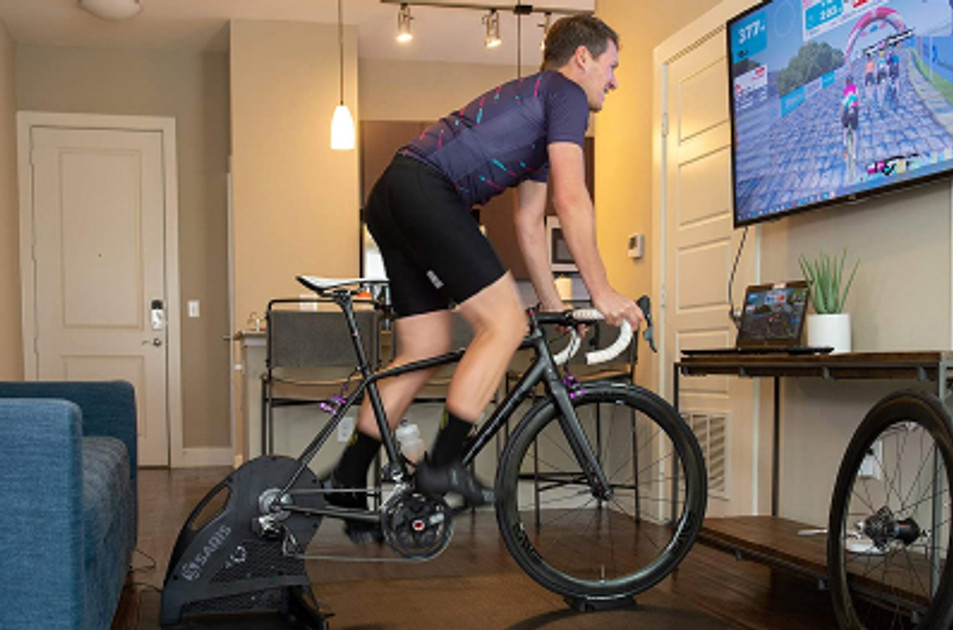
Turbo Trainers Explained
Posted by Marion Goodall - Eurocycles on 29th Sep 2021

Cycling is very much weather dependent and, while you can cycle in most conditions, wet, rainy and cold dark days don't make for fun cycling. But, this does not mean that you can't train and use your bike over the Winter. Thankfully, the turbo trainers are here to bring the gym home and allow you to cycle even when the weather outside is horrendous.
What are turbo trainers?
Turbo trainers are a means to create a static bike in your kitchen, shed, garage or spare room. They are easy to set up and easy to use. From the comfort of your own home, you can cycle for hours or only a few minutes whenever you wish, no matter the weather.
How do turbo trainers attach to your bike?
Turbo trainers connect to your bike and give resistance when you pedal to create an outdoor-like workout.
There are two main types of turbo trainers: direct-drive and wheel-on.

The wheel-on turbo trainers clamp around the quick-release skewer of your bike's rear wheel suspending it in an A-frame. These are cost-effective trainers which can be folded away into compact easy to carry frames. As they attach through the back skewer, there is no need to remove your back wheel every time you use it. However, this also means that your bike tyre is getting a fair amount of use and, it is recommended to invest in a turbo trainer tyre to preserve your normal tyre. Although lighter than the direct-drive turbo trainers, the wheel-on trainers tend to be louder and do not always offer smart features.
The direct-drive turbo trainers are the premium type of turbo trainers. They connect to your bike by removing your rear wheel and fitting on your chain. It involves a little more of a set-up but also offers much more than their wheel-on cousins. Direct-drive turbo trainers are quiet and smooth and, more often than not, come with built-in power meters and smart features. They can easily be connected to training apps like Zwift and Rouvy so you can get the most out of your training.
What are smart turbo trainers?

Smart turbo trainers are trainers that can connect to trainer apps like Rouvy, TrainerRoads and Zwift to enhance your training sessions.
Non-smart turbo trainers do not have built-in sensors and won't connect to training apps unless you buy separate speed and cadence sensors. These are the most budget-friendly type of trainers. They will suit anybody on a budget who's not looking to use any online training platforms.
One-way smart turbo trainers come with built-in speed and power sensors and connect to apps via ANT and Bluetooth. These are limited compared to the smart interactive turbo trainers as they do not offer control of the trainer's resistance via the app. This feature built-in the smart interactive trainers means that when you are doing a specific route on Zwift or any other app, the resistance given will adapt to the terrain the virtual ride brings you on. The resistance will increase as you tackle the hills.
Can turbo trainers be used with mountain bikes?
Although mainly designed for road bikes, some turbo trainers allow you to fit hybrid bikes or mountain bikes. Just check compatibility before purchasing your trainer.
What else do I need to get started with my turbo trainer?
Turbo trainers are ready to use once you have them set up, whether you had to fix the rear wheel onto it or place your chain onto the cassette of your direct drive turbo.
For wheel-on turbo trainers, you might want to fit a turbo specific tyre onto your rear wheel before going ahead with your first session, where the direct-drive turbos will require that you install a cassette onto it before starting. The Saris H3 turbo trainer is an example of this as it needs a cassette for you to be able to use it.
Once you are set, we recommend that you equip yourself with the following accessories:
- A towel: you'd be surprised how grateful you will be to have one handy when you are in the midst of your turbo session,
- A turbo trainer mat: the mat will prevent your bike and turbo from slipping off your kitchen tiles, protect your living room wood floors and dampen the noise made by the turbo. Saris does a great turbo trainer kit which includes a mat, a towel and a levelling block.
- A levelling block: the block will stabilise your front wheel and keep your bike level with your trainer.
- A bottle with plenty of water or energy drink to keep you hydrated.
- A fan: as turbo trainers are used indoors, you do not get the advantages of a cooling breeze and, a fan will make a world of difference when the room you are training in starts to get stuffy.
- A bike sweat guard: if you are someone who tends to sweat a lot, this little hammock-like contraption will protect your frame from the unwelcomed corrosive sweat.
Now you have all the information handy, just select one of our Saris turbo trainers to get started. Just follow the link below:




